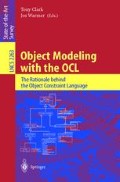Abstract
When OCL is applied in concrete examples, many questions arise about the precise meaning of OCL constraints. The same kind of difficulties appears when automatic support tools for OCL are designed. These questions are due to the lack of a precise semantics of OCL constraints in the context of a UML model. The aim of this paper is to contribute to a clarification of several issues, like interpretation of invariants and pre- and postconditions, treatment of undefined values, inheritance of constraints, transformation rules for OCL constraints and computation of proof obligations. Our study is based on a formal, abstract semantics of OCL.
Access this chapter
Tax calculation will be finalised at checkout
Purchases are for personal use only
Preview
Unable to display preview. Download preview PDF.
References
Bidoit, M., Hennicker, R., Tort, F., Wirsing, M.: Correct Realizations of Interface Constraints with OCL. Proc. UML’ 99, The Unified Modeling Language-Beyond the Standard, Springer LNCS 1723, 399–415, 1999.
Brickford, M., Guaspari, D.: Lightweight Analysis of UML. Draft Technical Report, Odyssey Research Associates, 1998.
Cheesman, J., Daniels, J.: UML Components. Addison-Wesley, 2001
The CIP Language Group (F.L. Bauer et al.): The Munich Project CIP, Vol. I: The Wide Spectrum Language CIP-L. Springer LNCS 183, 1985
Demuth, B., Hussmann, H.: Using UML/OCL Constraints for Relational Database Design. Proc. UML’ 99, The Unified Modeling Language-Beyond the Standard, Springer LNCS 1723, 598–613, 1999.
Demuth, B., Hussmann, H., Loecher, St.: OCL as a Specification Language for Business Rules in Data Base Applications. Proc. UML’ 01, The Unified Modeling Language, To appear (Springer LNCS), 2001.
D’souza, D.F., Wills, A.C.: Objects, Components and Frameworks with UML. The Catalysis Approach. Addison-Wesley, 1999
Fitzgerald, J., Larsen, P.G.: Modelling Systems. Practical Tools and Techniques in Software Development. Cambridge University Press, 1998
Floyd, R.W.: Assinging Meanings to Programs. Proc. Symp. on Appl. Math. 19, American Mathematical Society 1967
Gamma, E., Helm, R., Johnson, R., Vlissides, J.: Design Patterns. Elements of Reusable Object-Oriented Software. Addison-Wesley, 1995
Reus, B., Wirsing, M., Hennicker, R.: A Hoare Calculus for Verifying Java Realizations of OCL-Constrained Design Models. Proc. FASE 2001-Fundamental Aspects of Software Engineering, Springer LNCS 2029, 285–300, 2001.
Hoare, C.A.R.: An Axiomatic Basis of Computer Programming. Communications of the ACM 12, pp. 576–583, 1969
Hussmann, H., Demuth, B., Finger, F.: Modular Architecture for a Toolset Supporting OCL. Proc. UML 2000, The Unified Modeling Language-Advancing the Standard, Springer LNCS 1939, 278–293, 2000.
Liskov, B., Wing, J.: A Behavioral Notion of Subtyping. ACM Trans. on Prog. Lang. and Systems, Vol. 16 (6), 1811–1841, 1994
Meyer, B.: Object-oriented Software Construction. Prentice Hall, 1988.
Richters, M., Gogolla, M.: On Formalizing the UML Object Constraint Language OCL. Proc. 17th Int. Conf. Conceptual Modeling (ER’ 98) Springer LNCS 1507, 449–464, 1998.
Richters, M., Gogolla, M.: Validating UML Models and OCL Constraints. Proc. UML 2000, The Unified Modeling Language-Advancing the Standard, Springer LNCS 1939, 265–277, 2000.
Warmer, J., Kleppe, A.: The Object Constraint Language. Precise Modeling with UML. Addison-Wesley, 1999
Klasse Objecten: Errata for “The Object Constraint Language, Precise Modeling with UML”. Available at http://www.klasse.nl.
Author information
Authors and Affiliations
Editor information
Editors and Affiliations
Rights and permissions
Copyright information
© 2002 Springer-Verlag Berlin Heidelberg
About this chapter
Cite this chapter
Hennicker, R., Hussmann, H., Bidoit, M. (2002). On the Precise Meaning of OCL Constraints. In: Clark, T., Warmer, J. (eds) Object Modeling with the OCL. Lecture Notes in Computer Science, vol 2263. Springer, Berlin, Heidelberg. https://doi.org/10.1007/3-540-45669-4_5
Download citation
DOI: https://doi.org/10.1007/3-540-45669-4_5
Published:
Publisher Name: Springer, Berlin, Heidelberg
Print ISBN: 978-3-540-43169-5
Online ISBN: 978-3-540-45669-8
eBook Packages: Springer Book Archive

